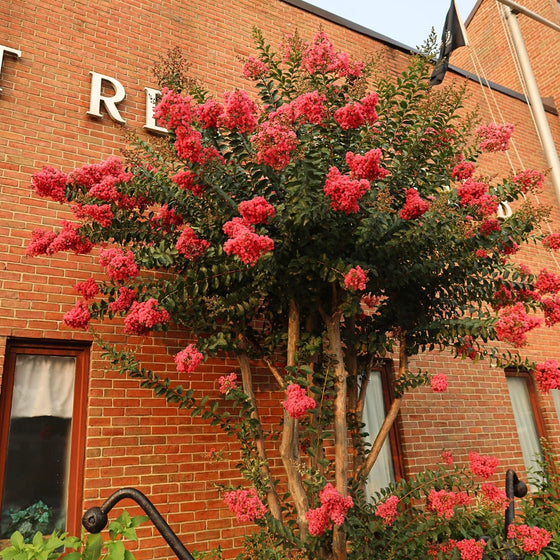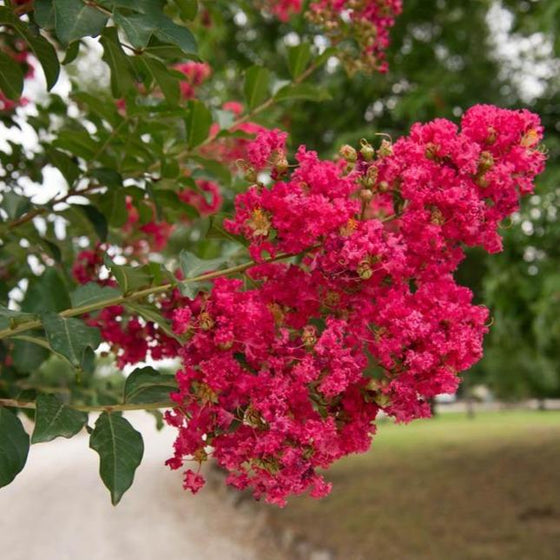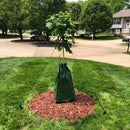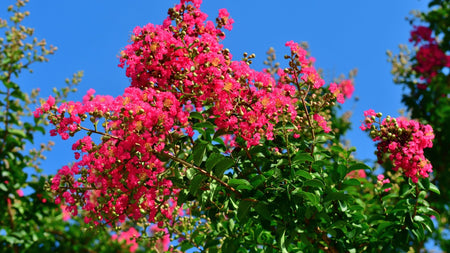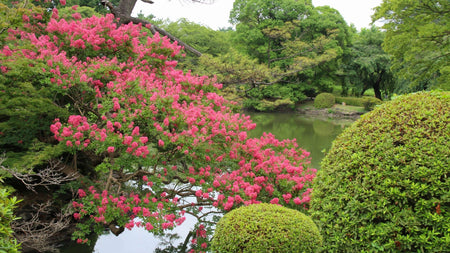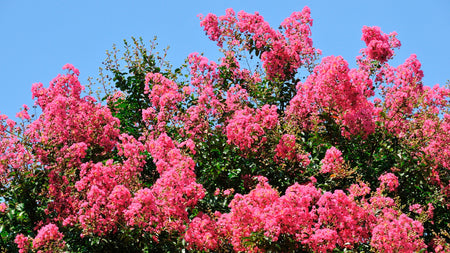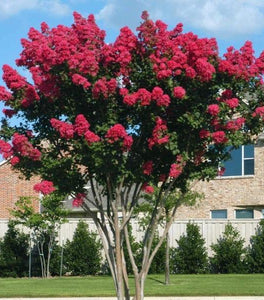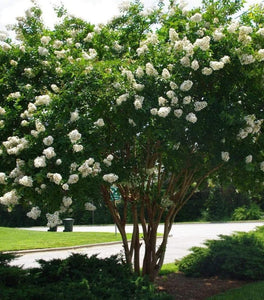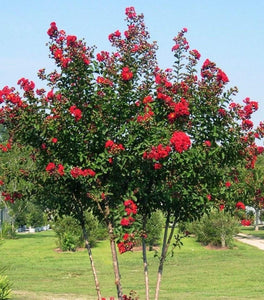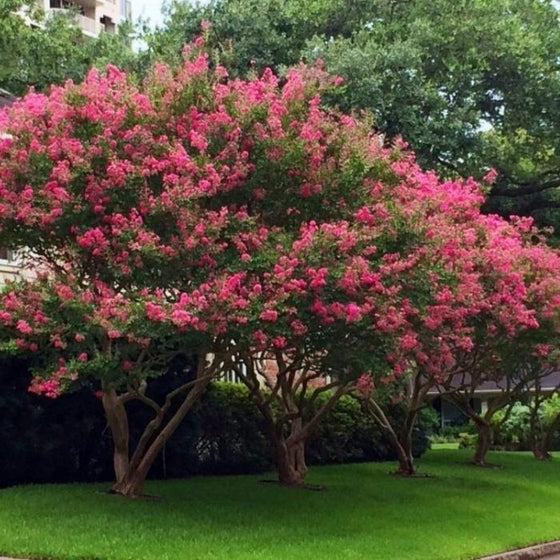
Images Depict Mature Plants
Tuscarora Crape Myrtle Trees
Tuscarora Crape Myrtle is a bold, eye-catching ornamental tree prized for its vibrant coral-pink blooms and smooth, cinnamon-colored bark. Blooming from mid-summer through early fall, Tuscarora delivers months of dazzling color that enhances both residential and commercial landscapes. This large, upright variety can reach 15 to 20 feet tall and 12 to 15 feet wide at maturity, making it ideal as a flowering focal point, street tree, or privacy screen. Its long-lasting, ruffled blooms stand out beautifully against its glossy green foliage, which transitions to shades of orange and red in the fall.
Exceptionally tough and easy to care for, Tuscarora Crape Myrtle thrives in full sun and well-draining soil, with excellent tolerance to heat, humidity, and drought once established. It is highly resistant to powdery mildew and other common Crape Myrtle diseases, making it a low-maintenance choice for gardeners who want reliable performance without constant upkeep. Tuscarora’s multi-season appeal—from summer flowers to attractive winter bark—adds year-round interest and structure to a wide range of landscape designs.
In addition to its stunning visual appeal, Tuscarora Crape Myrtle also supports pollinators by attracting bees, butterflies, and other beneficial insects during its bloom period. Whether planted as a single specimen, grouped in a flowering border, or used in allees and avenues, Tuscarora brings vibrant color, strong architectural form, and lasting beauty to any sun-filled garden or landscape. Its impressive size, disease resistance, and colorful display make it one of the most popular large Crape Myrtle varieties for both homeowners and landscape professionals.
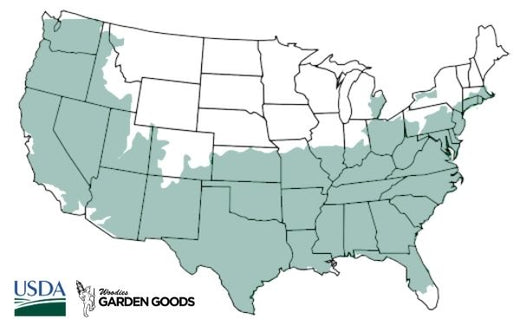
| Hardiness Zone: | 6-9 |
|---|---|
| Mature Height: | 15 to 20 feet |
| Mature Width: | 10 to 14 feet |
| Classification: | Tree form mid-size (10 to 20 feet) |
| Sunlight: | Full sun |
| Habit: | Deciduous, densely branched, multi-stemmed habit |
| Flower Color: | Dark coral-Pink flowers in mid to late summer through the first frost |
| Foliage: | New growth emerges a rich dark green, changing to a equally vibrant orange-red in the fall |
| Soil Condition: | Any well drained soil |
| Water Requirements: | Water well until established |
| Uses: | Extremely attractive when used as a focal point in the mixed border, mass planting, or a specimen planting. Small enough for a large containers on the patio |
How to Care for Tuscarora Crape Myrtle
Be sure to read about the recommended care instructions to keep your Tuscarora Crape Myrtle Trees healthy and thriving!
How should I plant my Tuscarora Crape Myrtle trees?
To plant your Tuscarora Crape Myrtle trees, choose a location that receives full sun for at least six hours a day, which is essential for producing abundant coral-pink blooms. Begin by digging a hole twice as wide as the root ball and just as deep, loosening the surrounding soil to promote healthy root development. Position the tree so the top of the root ball is level with or slightly above the surrounding soil, then backfill with a mix of native soil and compost to enhance drainage and nutrient content. Water thoroughly after planting to eliminate air pockets, and apply a 2–3 inch layer of mulch around the base, keeping it a few inches away from the trunk to prevent rot. When planting Tuscarora Crape Myrtles, be sure to provide enough space for their mature size—typically 15 to 20 feet tall and 12 to 15 feet wide. Proper spacing ensures good air circulation, which helps reduce the risk of disease and allows the tree to develop its natural vase-shaped canopy. These trees make excellent standalone specimens, flowering borders, or privacy screens along driveways or property lines. With the right site preparation and thoughtful placement, your Tuscarora Crape Myrtle will establish quickly and reward you with years of vivid blooms, attractive bark, and fall color.
How do I water my Tuscarora Crape Myrtle?
When watering your Tuscarora Crape Myrtle trees, it's important to focus on deep, consistent soakings, especially during the first growing season. Water the tree thoroughly once or twice a week, depending on rainfall and soil type, to ensure the root zone remains evenly moist but not waterlogged. Always water at the base of the tree rather than overhead to prevent fungal diseases and promote deep root growth. Establishing a strong root system early on is essential for long-term drought tolerance and healthy, vigorous blooming. Once established, Tuscarora Crape Myrtles become highly drought tolerant and typically only need supplemental watering during prolonged dry spells or extreme heat. Check the soil a few inches below the surface—if it feels dry, it's time to water. Applying a 2–3 inch layer of mulch around the base of the tree can help conserve moisture, regulate soil temperature, and reduce watering frequency. With proper watering practices, your Tuscarora Crape Myrtle will thrive, delivering season after season of brilliant coral-pink flowers, rich fall foliage, and striking exfoliating bark.
How should I Fertilize My Tuscarora Crape Myrtle Trees?
To fertilize your Tuscarora Crape Myrtle trees, apply a balanced, slow-release fertilizer—such as a 10-10-10 or 12-4-8 formulation—in early spring as new growth begins. Distribute the fertilizer evenly around the drip line of the tree, avoiding direct contact with the trunk, and water thoroughly to help nutrients reach the root zone. This spring application supports strong branching, healthy foliage, and an abundance of coral-pink blooms throughout the summer. Avoid excessive nitrogen, as it can promote leafy growth at the expense of flowers. For continued vigor, you can apply a light second feeding of fertilizer in mid to late summer, especially in poor or sandy soils where nutrients deplete quickly. Additionally, enriching the soil with organic compost or mulch each year will help improve soil structure and provide a steady nutrient source over time. Be sure to follow the manufacturer’s application rates to prevent overfertilization, which can lead to weak growth or fewer blooms. With proper fertilization, your Tuscarora Crape Myrtle will reward you with vibrant color, healthy structure, and reliable performance season after season.

How and When Should I prune my Tuscarora Crape Myrtle Trees?
You should prune your Crape Myrtle in late winter or very early spring, just before new growth begins. This is the ideal time to shape the tree without cutting off developing flower buds, which form on new wood. Begin by removing any dead, diseased, or crossing branches to promote healthy airflow and strong structure. You can also thin out crowded interior branches and prune suckers from the base to maintain the tree's elegant, vase-like form. Avoid cutting back the main trunks, a practice known as "crape murder," which leads to weak, spindly regrowth and fewer blooms. When pruning your Crape Myrtle, focus on enhancing its natural shape rather than drastically reducing its height. Lightly shaping the canopy encourages better flower production and maintains a balanced appearance throughout the growing season. For repeat-blooming varieties, you can also deadhead spent flower clusters in summer to encourage a second flush of blooms. Proper pruning not only improves the overall health and structure of the tree but also maximizes its display of vibrant summer flowers, colorful fall foliage, and attractive winter bark.

